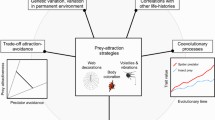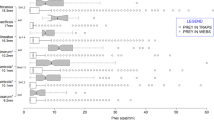Abstract
One of the benefits of cooperative hunting may be that predators can subdue larger prey. In spiders, cooperative, social species can capture prey many times larger than an individual predator. However, we propose that cooperative prey capture does not have to be associated with larger caught prey per se, but with an increase in the ratio of prey to predator body size. This can be achieved either by catching larger prey while keeping predator body size constant, or by evolving a smaller predator body size while maintaining capture of large prey. We show that within a genus of relatively large spiders, Stegodyphus, subsocial spiders representing the ancestral state of social species are capable of catching the largest prey available in the environment. Hence, within this genus, the evolution of cooperation would not provide access to otherwise inaccessible, large prey. Instead, we show that social Stegodyphus spiders are smaller than their subsocial counterparts, while catching similar sized prey, leading to the predicted increase in prey-predator size ratio with sociality. We further show that in a genus of small spiders, Anelosimus, the level of sociality is associated with an increased size of prey caught while predator size is unaffected by sociality, leading to a similar, predicted increase in prey-predator size ratio. In summary, we find support for our proposed ‘prey to predator size ratio hypothesis’ and discuss how relaxed selection on large body size in the evolution of social, cooperative living may provide adaptive benefits for ancestrally relatively large predators.





Similar content being viewed by others

References
Agnarsson I, Aviles L, Coddington JA, Maddison WP (2006) Sociality in theridiid spiders: Repeated origins of an evolutionary dead end. Evolution 60(11):2342–2351
Avilés L (1997) Causes and consequences of cooperation and permanent-sociality in spiders. In: Choe JC, Crespi BJ (eds) The Evolution of Social Behavior in Insects and Arachnids. Cambridge University Press, Cambridge, pp 476–498
Aviles L, Guevara J (2017) Sociality in spiders. In: Rubenstein DR, Abbot P (eds) Comparative Social Evolution. Cambridge Cambridge University Press, pp 188–223
Aviles L, Harwood G (2012) A quantitative index of sociality and its application to group-living spiders and other social organisms. Ethology 118(12):1219–1229. https://doi.org/10.1111/eth.12028
Aviles L, Tufino P (1998) Colony size and individual fitness in the social spider Anelosimus eximius. Am Nat 152(3):403–418. https://doi.org/10.1086/286178
Aviles L, Agnarsson I, Salazar PA, Purcell J, Iturralde G, Yip EC et al (2007) Natural history miscellany - altitudinal patterns of spider sociality and the biology of a new midelevation social Anelosimus species in Ecuador. Am Nat 170(5):783–792. https://doi.org/10.1086/521965
Bates D, Maechler M, Bolker B, Walker S (2015) Fitting linear mixed-effects models using lme4. J Stat Softw 67(1):1–48. https://doi.org/10.18637/jss.v067.i01
Bilde T, Lubin Y, Smith D, Schneider JM, Maklakov AA (2005) The transition to social inbred mating systems in spiders: role of inbreeding tolerance in a subsocial predecessor. Evolution 59(1):160–174
Bilde T, Coates KS, Birkhofer K, Bird T, Maklakov AA, Lubin Y, Aviles L (2007) Survival benefits select for group living in a social spider despite reproductive costs. J Evol Biol 20(6):2412–2426. https://doi.org/10.1111/j.1420-9101.2007.01407.x
Caraco T, Wolf LL (1975) Ecological determinants of group sizes of foraging lions. Am Nat 109(967):343–352. https://doi.org/10.1086/283001
Creel S, Creel NM (1995) Communal hunting and pack size in African wild dogs, Lycaon-Pictus. Anim Behav 50:1325–1339. https://doi.org/10.1016/0003-3472(95)80048-4
Crouch TE, Lubin Y (2000) Effects of climate and prey availability on foraging in a social spider, Stegodyphus mimosarum (Araneae, Eresidae). J Arachnol 28(2):158–168. https://doi.org/10.1636/0161-8202(2000)028[0158:Eocapa]2.0.Co;2
Fernandez-Fournier P, Guevara J, Hoffman C, Aviles L (2018) Trait overdispersion and the role of sociality in the assembly of social spider communities across the Americas. Proc Natl Acad Sci U S A 115(23):6010–6015. https://doi.org/10.1073/pnas.1721464115
Grinsted L, Lubin Y (2019) Spiders: evolution of group living and social behavior. In: Choe JC (ed) Encyclopedia of animal behavior, vol 4, 2nd edn. Elsevier, Academic Press, pp 632–640
Grinsted L, Pruitt JN, Settepani V, Bilde T (2013) Individual personalities shape task differentiation in a social spider. Proce R Soc B-Biol Sci 280(1767):ARTN 20131407. https://doi.org/10.1098/rspb.2013.1407
Grinsted L, Breuker CJ, Bilde T (2014) Cooperative breeding favors maternal investment in size over number of eggs in spiders. Evolution 68(7):1961–1973. https://doi.org/10.1111/evo.12411
Guevara J, Gonzaga MO, Vasconcellos-Neto J, Aviles L (2011) Sociality and resource use: insights from a community of social spiders in Brazil. Behav Ecol 22(3):630–638. https://doi.org/10.1093/beheco/arr022
Hadfield JD (2010) MCMC methods for multi-response generalized linear mixed models: the MCMCglmm R package. J Stat Softw 33(2):1–22
Harmon LJ, Weir JT, Brock CD, Glor RE, Challenger W (2008) GEIGER: investigating evolutionary radiations. Bioinformatics 24(1):129–131. https://doi.org/10.1093/bioinformatics/btm538
Jacson CC, Joseph KJ (1973) Life-history, bionomics and behavior of social spider Stegodyphus-Sarasinorum Karsch. Insect Soc 20(2):189–203. https://doi.org/10.1007/Bf02223347
Johannesen J, Lubin Y, Smith DR, Bilde T, Schneider JM (2007) The age and evolution of sociality in Stegodyphus spiders: a molecular phylogenetic perspective. Proc R Soc B Biol Sci 274(1607):231–237. https://doi.org/10.1098/rspb.2006.3699
Junghanns A, Holm C, Schou MF, Sorensen AB, Uhl G, Bilde T (2017) Extreme allomaternal care and unequal task participation by unmated females in a cooperatively breeding spider. Anim Behav 132:101–107. https://doi.org/10.1016/j.anbehav.2017.08.006
Kraus O, Kraus M (1988) The genus Stegodyphus (Arachnida, Araneae). Sibling species, species groups, and parallel origin of social living. In: Kraus O (ed) Verhandlungen des Naturwissenschaftlichen Vereins in Hamburg (NF) 30. Verlag Paul Parey, Hamburg and Berlin, pp 151–254
Lubin Y, Bilde T (2007) The evolution of sociality in spiders. Adv Study Behav 37:83–145
Majer M, Agnarsson I, Svenning JC, Bilde T (2013a) Social spiders of the genus Anelosimus occur in wetter, more productive environments than non-social species. Naturwissenschaften 100(11):1031–1040. https://doi.org/10.1007/s00114-013-1106-6
Majer M, Svenning JC, Bilde T (2013b) Habitat productivity constrains the distribution of social spiders across continents - case study of the genus Stegodyphus. Front Zool 10:Artn 9. https://doi.org/10.1186/1742-9994-10-9
Majer M, Svenning J-C, Bilde T (2015) Habitat productivity predicts the global distribution of social spiders. [Original Research]. Front Ecol Evol 3(101). https://doi.org/10.3389/fevo.2015.00101
Majer M, Holm C, Lubin Y, Bilde T (2018) Cooperative foraging expands dietary niche but does not offset intra-group competition for resources in social spiders. Sci Rep 8:ARTN 11828. https://doi.org/10.1038/s41598-018-30199-x
Nentwig W (1985) Social spiders catch larger prey - a study of Anelosimus-eximius (Araneae, Theridiidae). Behav Ecol Sociobiol 17(1):79–85. https://doi.org/10.1007/Bf00299433
Nentwig W, Wissel C (1986) A comparison of prey lengths among spiders. Oecologia 68(4):595–600. https://doi.org/10.1007/Bf00378777
Nudds TD (1978) Convergence of group-size strategies by mammalian social carnivores. Am Nat 112(987):957–960. https://doi.org/10.1086/283336
Pinheiro J, Bates D, DebRoy S, Sarkar D (2019) nlme: linear and nonlinear mixed effects models, R package version 3.1-138, from https://CRAN.R-project.org/package=nlme
Platt TG, Bever JD (2009) Kin competition and the evolution of cooperation. Trends Ecol Evol 24(7):370–377. https://doi.org/10.1016/j.tree.2009.02.009
Powers KS, Aviles L (2007) The role of prey size and abundance in the geographical distribution of spider sociality. J Anim Ecol 76(5):995–1003. https://doi.org/10.1111/j.1365-2656.2007.01267.x
R Core Team (2019) R: a language and environment for statistical computing, from https://www.R-project.org/
Rezac M, Pekar S, Johannesen J (2008) Taxonomic review and phylogenetic analysis of central European Eresus species (Araneae : Eresidae). Zool Scr 37(3):263–287. https://doi.org/10.1111/j.1463-6409.2008.00328.x
Schneider JM (1997) Timing of maturation and the mating system of the spider, Stegodyphus lineatus (Eresidae): How important is body size? Biol J Linn Soc 60(4):517–525
Seibt U, Wickler W (1988) Why Do Family Spiders, Stegodyphus (Eresidae), Live in Colonies. J Arachnol 16(2):193–198
Settepani V, Grinsted L, Granfeldt J, Jensen JL, Bilde T (2013) Task specialization in two social spiders, Stegodyphus sarasinorum (Eresidae) and Anelosimus eximius (Theridiidae). J Evol Biol 26(1):51–62. https://doi.org/10.1111/jeb.12024
Settepani V, Bilde T, Grinsted L (2015) Temporarily social spiders do not show personality-based task differentiation. Anim Behav 105:95–102. https://doi.org/10.1016/j.anbehav.2015.04.006
Settepani V, Bechsgaard J, Bilde T (2016) Phylogenetic analysis suggests that sociality is associated with reduced effectiveness of selection. Ecol Evol 6(2):469–477. https://doi.org/10.1002/ece3.1886
Settepani V, Schou MF, Greve M, Grinsted L, Bechsgaard J, Bilde T (2017) Evolution of sociality in spiders leads to depleted genomic diversity at both population and species levels. Mol Ecol 26(16):4197–4210. https://doi.org/10.1111/mec.14196
Simpson MR (1995) Covariation of spider egg and clutch size - the influence of foraging and parental care. Ecology 76(3):795–800. https://doi.org/10.2307/1939345
Stearns SC, Koella JC (1986) The evolution of phenotypic plasticity in life-history traits - Predictions of reaction norms for age and size at maturity. Evolution 40(5):893–913. https://doi.org/10.2307/2408752
Venner S, Casas J (2005) Spider webs designed for rare but life-saving catches. Proce R Soc B-Biol Sci 272(1572):1587–1592. https://doi.org/10.1098/rspb.2005.3114
Villemereuil P, Gimenez O, Doligez B (2013) Comparing parent-offspring regression with frequentist and Bayesian animal models to estimate heritability in wild populations: a simulation study for Gaussian and binary traits. Methods Ecol Evol 4(3):260–275. https://doi.org/10.1111/2041-210x.12011
Ward PI (1986) Prey availability increases less quickly than nest size in the social spider Stegodyphus-mimosarum. Behaviour 97:213–225. https://doi.org/10.1163/156853986x00603
Ward D, Lubin Y (1993) Habitat selection and the life-history of a desert spider, Stegodyphus-lineatus (Eresidae). J Anim Ecol 62(2):353–363. https://doi.org/10.2307/5366
World Spider Catalog. (2019). World Spider Catalog. Version 20.0 Retrieved 14.05.19, from http://wsc.nmbe.ch
Yip EC, Rayor LS (2014) Maternal care and subsocial behaviour in spiders. Biol Rev 89(2):427–449. https://doi.org/10.1111/brv.12060
Yip EC, Powers KS, Aviles L (2008) Cooperative capture of large prey solves scaling challenge faced by spider societies. Proc Natl Acad Sci U S A 105(33):11818–11822. https://doi.org/10.1073/pnas.0710603105
Acknowledgements
We would like to thank Y. Lubin, C. Tuni, M. Majer, I. Musli, I. Hoffman, L. L. Chobolo and G. M. Dintwe for help collecting field data. We thank the Schoeman family in Namibia, the Agastya International Foundation and R. Balakrishnan in India, and Y. Lubin in Israel for additional help and hosting. We also thank I. Agnarsson and J. Bechsgaard for providing us with phylogenies.
Funding
L.G. was supported by The Leverhulme Trust (Early Career Fellowship: ECF-2016-080). C.H. was supported by the European Research Council (ERC StG-2011-282163 awarded to T.B.). Field work was carried out with financing from Drylands Research SSA grant awarded to C.H. (EC contract number: 026064).
Author information
Authors and Affiliations
Corresponding author
Additional information
Communicated by Matthias Pechmann
Publisher’s note
Springer Nature remains neutral with regard to jurisdictional claims in published maps and institutional affiliations.
This article is part of the Special Issue "Crossroads in Spider Research - evolutionary, ecological and economic significance"
Rights and permissions
About this article
Cite this article
Grinsted, L., Schou, M.F., Settepani, V. et al. Prey to predator body size ratio in the evolution of cooperative hunting—a social spider test case. Dev Genes Evol 230, 173–184 (2020). https://doi.org/10.1007/s00427-019-00640-w
Received:
Accepted:
Published:
Issue Date:
DOI: https://doi.org/10.1007/s00427-019-00640-w



